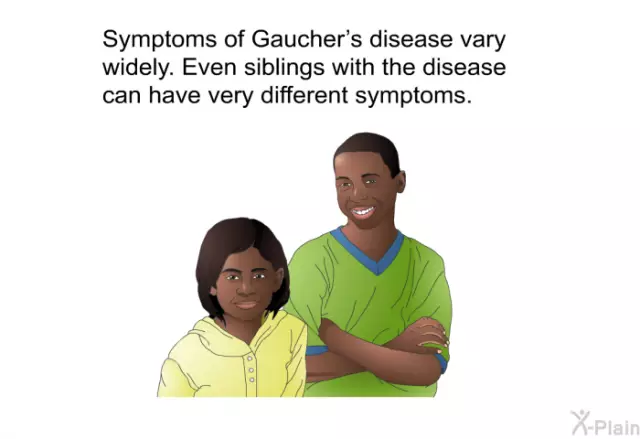- Author Rachel Wainwright [email protected].
- Public 2023-12-15 07:39.
- Last modified 2025-11-02 20:14.
Gaucher disease

Gaucher disease is a genetic disorder in which fatty substances (lipids) accumulate in cells and on some organs. Gaucher disease is the most common of the lysosomal storage diseases. It is a form of sphingolipidosis (a subgroup of lysosomal storage diseases), as it manifests itself in the dysfunctional metabolism of sphingolipids.
The disorder is characterized by fatigue, anemia, low blood platelets, and enlarged liver and spleen. This is due to a hereditary deficiency of the enzyme glucocerebrosidase, which acts on fatty acid glucosylceramide. When the enzyme is damaged, glucosylceramide accumulates, in particular, in leukocytes, most often in macrophages (mononuclear leukocytes). Glucosylceramide can accumulate in the spleen, liver, kidneys, lungs, brain, and bone marrow.
Gaucher disease can include enlarged spleen and liver, severe neurological complications, swelling of the lymph nodes and surrounding joints, bloating, brownish skin color, anemia, low platelet counts in the blood and sclera.
The disease is caused by a recessive mutation in a gene located on chromosome 1 and affects both men and women. About 1 in 100 people worldwide carry Gaucher disease. The disease is named after the French physician Philippe Gaucher, who originally described it in 1882.
Types of Gaucher disease
Gaucher disease has three general clinical subtypes: type I, type II, and type III.
Type I is the most common form of the disease, with an incidence of 1 in 50,000 newborns. Symptoms of this type of Gaucher disease can manifest early in life or into adulthood and include:
- Enlarged liver and greatly enlarged spleen;
- Weakness of skeletal bones;
- Anemia, thrombocytopenia, and leukopenia;
- Kidney damage;
- Fatigue.
Type II usually begins to appear within the first six months of birth and occurs with an incidence of about 1 in 100,000 newborns. Symptoms of this type of Gaucher disease include:
- Enlargement of the liver and spleen;
- Extensive and progressive brain damage;
- Eye movement disorders, spasticity, seizures and limb stiffness;
- Weak ability to suck and swallow.
Affected children usually die at the age of 2 years.
Type III (the chronic neuropathic form) can begin at any time, during childhood or even adulthood, and occurs with an incidence of 1 in 100,000 newborns. Major symptoms include an enlarged spleen or liver, seizures, poor coordination, breathing problems, skeletal abnormalities, eye movement disorders, and blood disorders including anemia.
Gaucher disease symptoms
Common symptoms of Gaucher disease are:
- Painless hepatomegaly and splenomegaly - the size of the spleen can be from 1500 to 3000 ml, as opposed to the normal size of 50-200 ml. Splenomegaly can reduce appetite by putting pressure on the abdomen, and enlarged spleen increases the risk of rupture of the spleen;
- Hypersplenism and pancytopenia - rapid and premature destruction of blood cells, resulting in anemia, neutropenia, leukopenia and thrombocytopenia (with an increased risk of infection and bleeding);
- Cirrhosis of the liver;
- Severe joint and bone pain, often in the hip and knee joints
- Neurological symptoms;
- Type II: severe seizures, hypertension, mental retardation, apnea;
- Type III: muscle twitching, seizures, dementia, ocular muscle apraxia;
- Osteoporosis;
- Yellowish brown skin pigmentation.
Treatment for Gaucher disease

Treatment for Gaucher disease subtypes 1 and 3 may begin with intravenous replacement of the recombinant glucocerebrosidase enzyme, which can significantly reduce liver and spleen size, skeletal abnormalities, and reverse other manifestations. This procedure costs about $ 200,000 per patient and must be repeated annually throughout the patient's life. Gaucher disease is also treated with the drug Velaglucerase Alfa, which has been approved as an alternative treatment since February 2010.
Also, the treatment for Gaucher disease can be a successful bone marrow transplant, which treats non-neurological manifestations of the disease, since monocytes with active beta-glucosidase are injected during the procedure. However, this procedure carries significant risks and is rarely recommended for Gaucher disease.
Surgery to remove the spleen (splenectomy) is rarely required if the patient is anemic or when an enlarged organ affects the patient's health. A blood transfusion may take place for patients with symptoms of anemia. Also, in some cases, surgical joint replacement is required to improve mobility and quality of life.
Other treatments for Gaucher disease include antibiotics for infections, antiepileptics, bisphosphonates for bone lesions, and liver transplants.
Gaucher disease is also treated with oral medications that act at the molecular level. Miglustat is one of these drugs and was approved for the treatment of Gaucher disease in 2003.
YouTube video related to the article:
The information is generalized and provided for informational purposes only. At the first sign of illness, see your doctor. Self-medication is hazardous to health!






